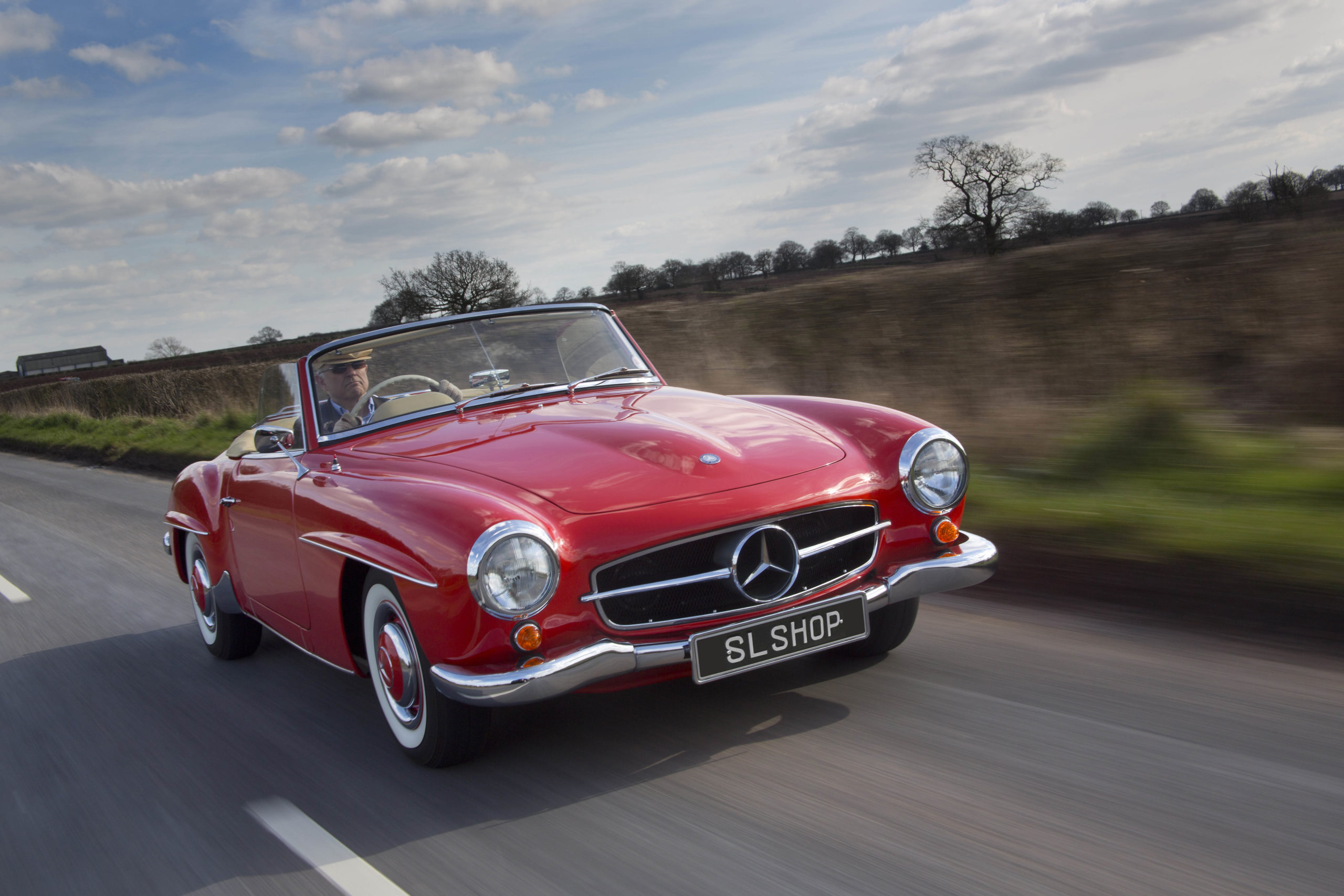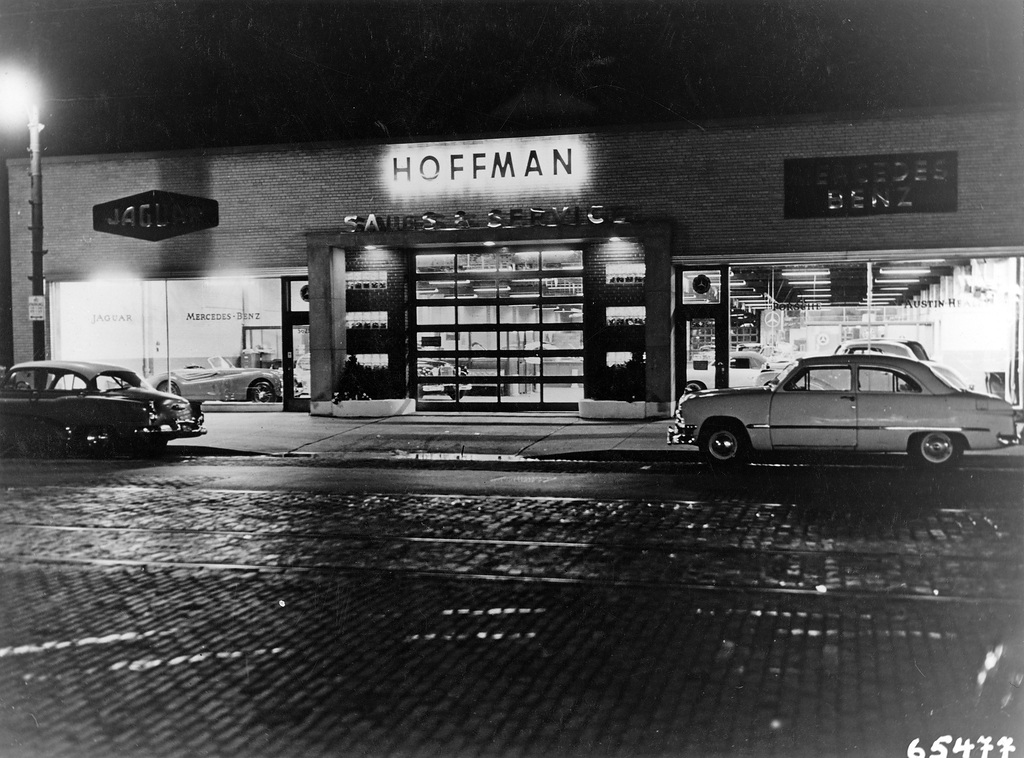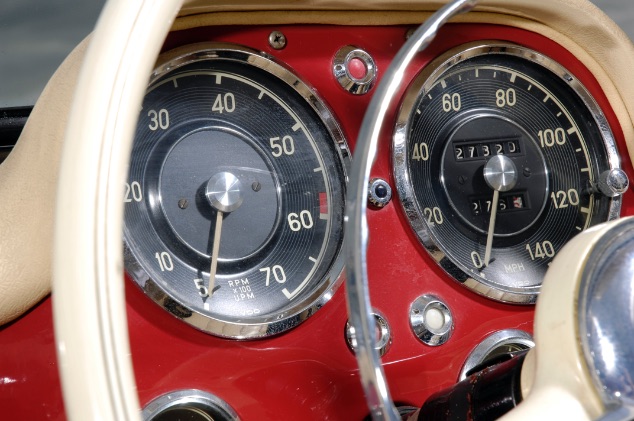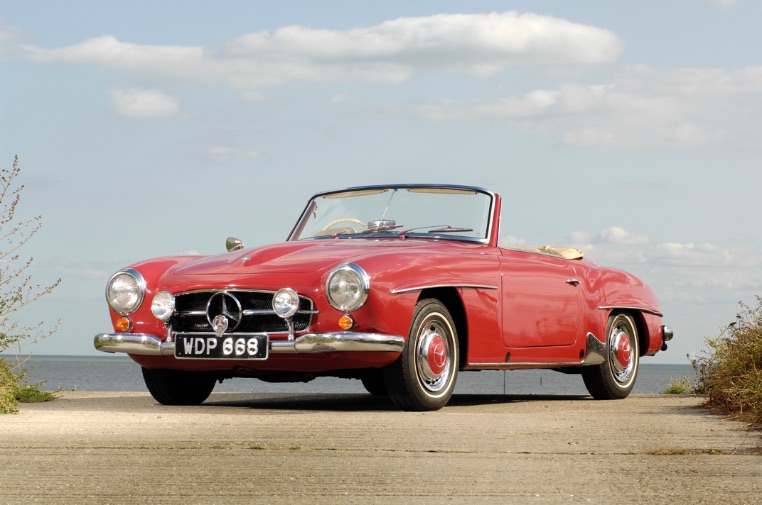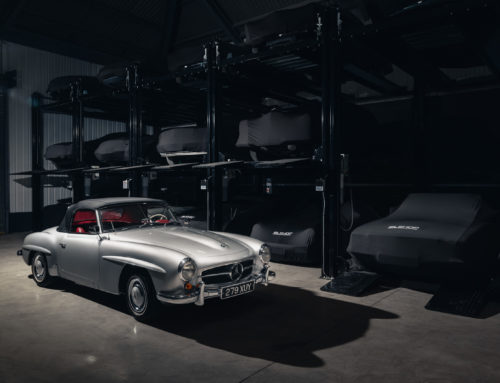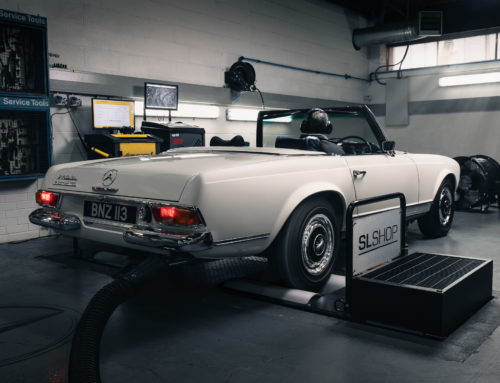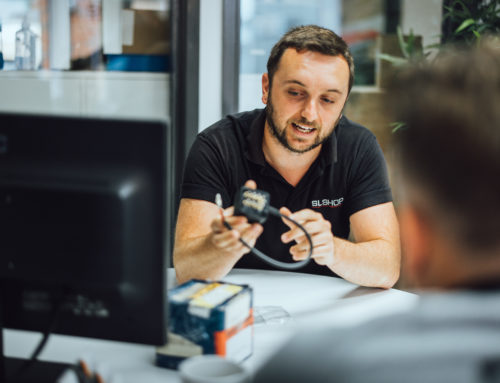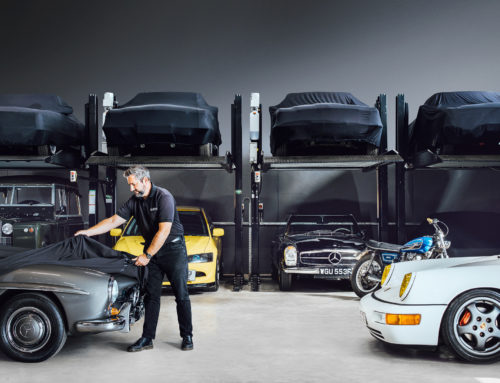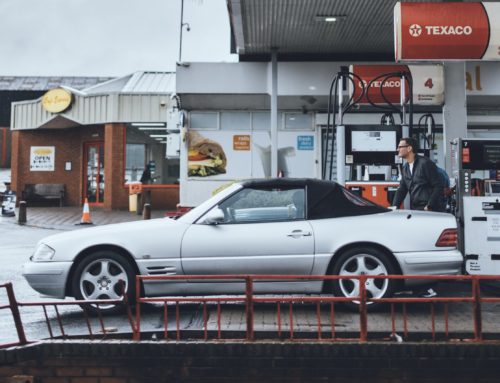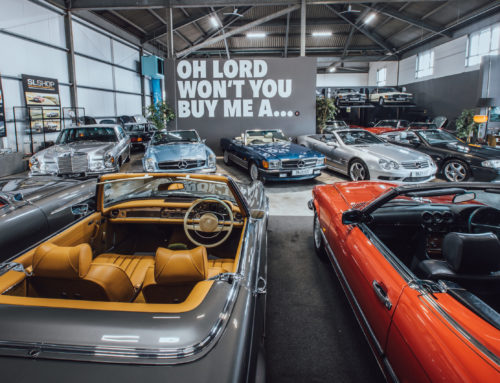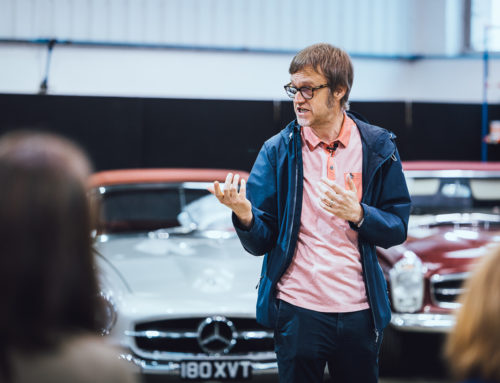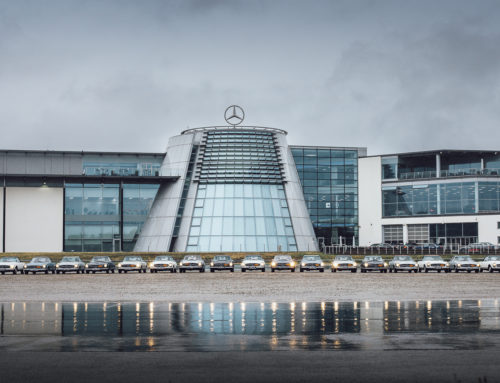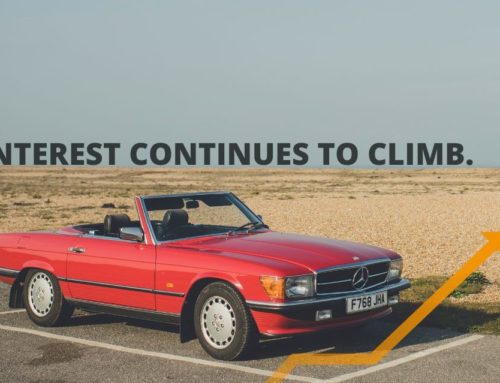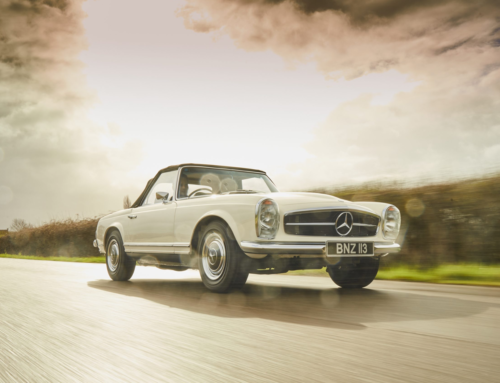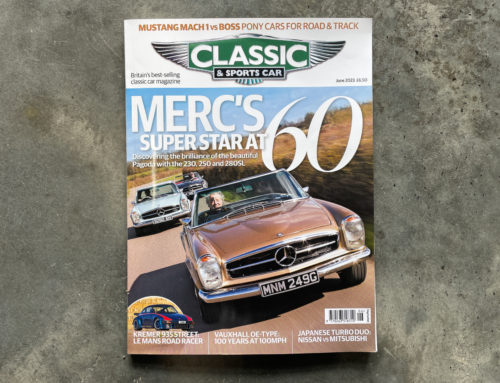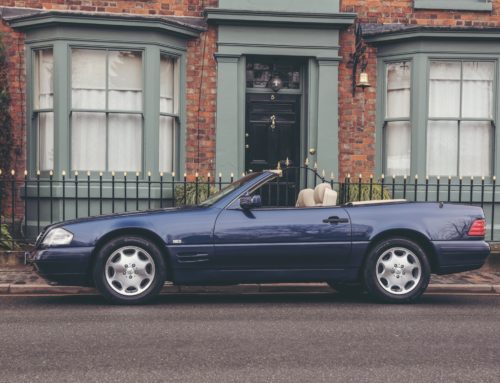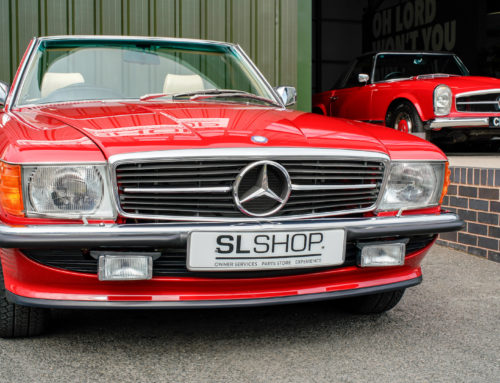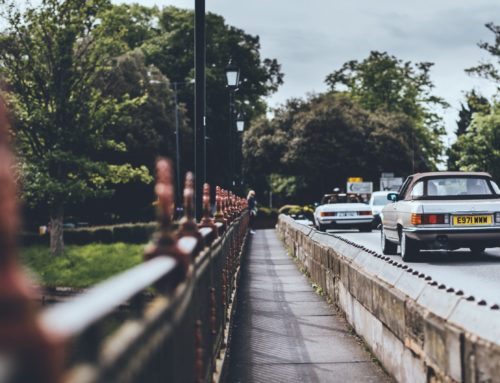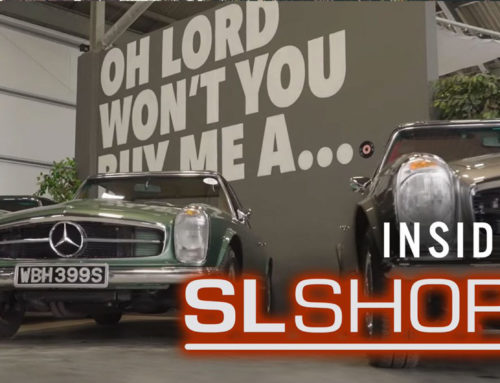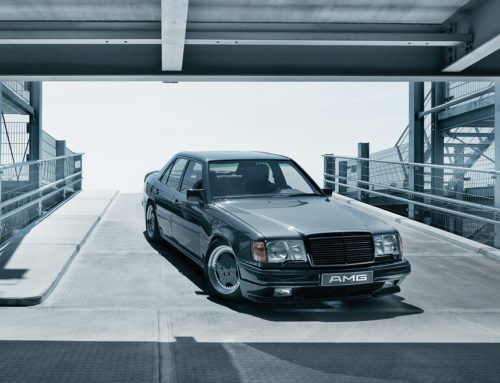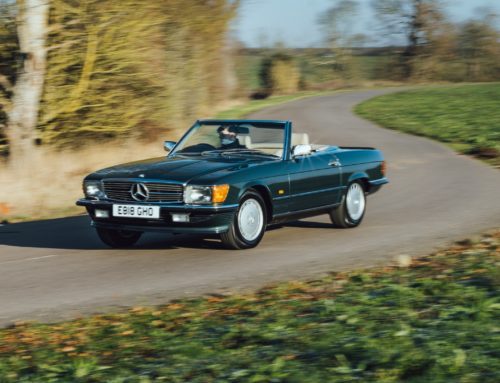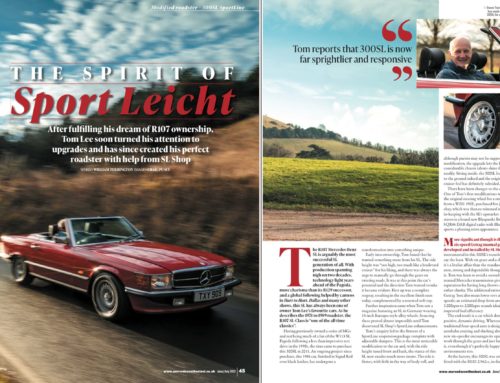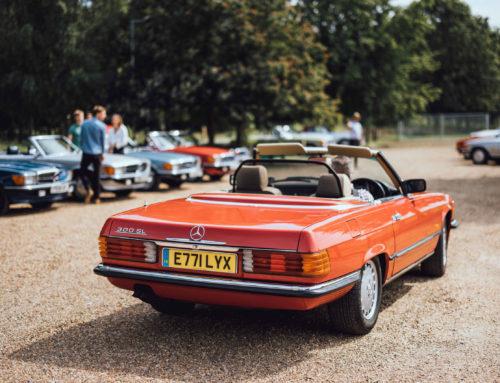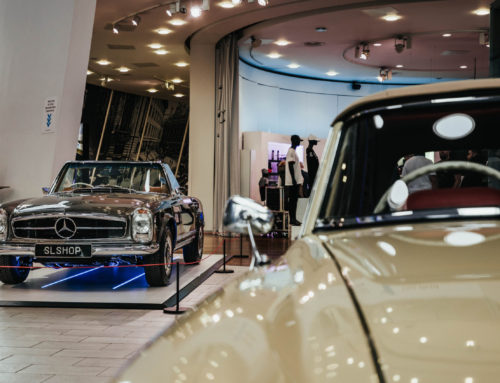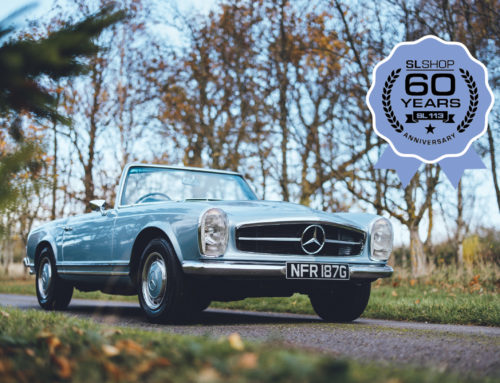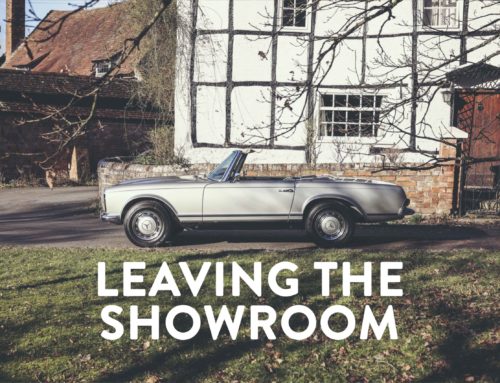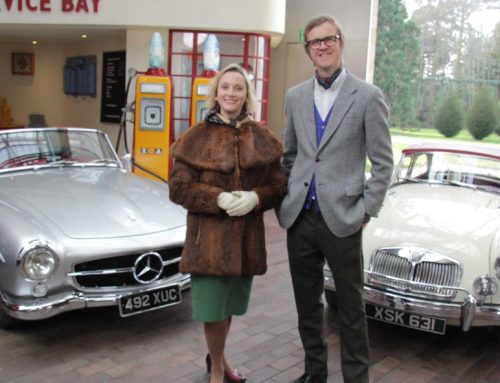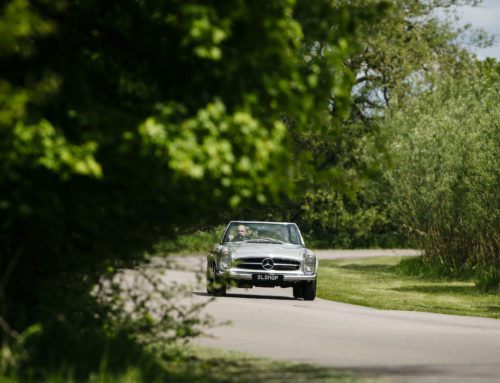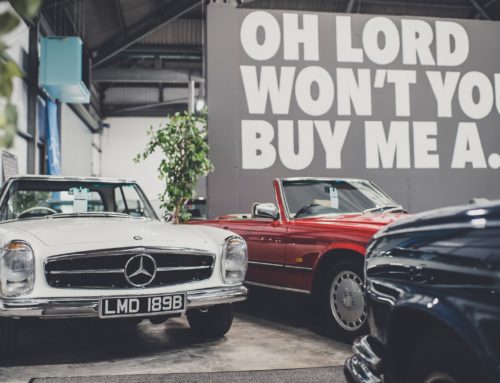It’s the Mercedes 190 SL that kicked off the lineage as we know it. It emerged from the halcyon days of the post war miracle. This German American ‘boomer’ healed old wounds and made dreams come true.
The International Motor Sports Show, took place during a typically cold New York February back in 1954. At the time those attending didn’t know that they were to witness the birth of something very special. Barely a decade after the end of the Second World War, a modest Mercedes-Benz display was dwarfed by that of next-door neighbours (and fierce rivals) Jaguar. Yet two of the Stuttgart concern’s four cars exhibited that week would prove pivotal to the firm’s 1950s revival. Pride of place was naturally reserved for the headline-grabbing 300SL ‘Gullwing’. But in its shadow was the handsome Mercedes 190 SL prototype convertible. It would go on to successfully extend the SL name from the racetrack to the road. The beloved Mercedes 190 SL as we now know it.
The American Dream
By the mid-1950s Americana had become the cultural and aspirational blueprint for much of the developed world. Emerging largely unscathed and economically booming post-War, America was riding high. Car ownership exploded and towards the end of the decade, baby boomers were now old enough to drive. These hip youngsters wouldn’t be seen dead in the bland saloons their parents drove. They wanted new and exciting cars that reflected their rock & roll lifestyle. New exciting cars like the Ford Thunderbird and Chevrolet Corvette that exuded sex appeal. Mercedes-Benz didn’t build anything like this (for the same price) at the time. They probably wouldn’t have done so, were it not for the machinations of a certain Maximillian Edwin Hoffman.
Austrian-born Hoffman had made his name as a prolific importer of European luxury and sports cars. He sold thousands annually from his famous Llyod-Wright designed Manhattan showrooms. Hoffman’s credits included persuading BMW to make its 507 and Porsche its 356 Speedster. As a result, when he told manufactures what his American customers wanted, they listened.
A New Era
Hoffman mentioned to Mercedes-Benz that if it made a convertible sports car, he could sell it. The competition success of the 300SL gave the brand the ideal jump-off for a salesman after all. He’d already managed to twist Stuttgart’s arm into making the 300SL road car a reality – even at an eye-wateringly expensive cost to the customer of $7000. What they needed was a new, affordable roadster that could compete on US soil with the aforementioned Fords and Chevys and cost less than $4000. The Mercedes 190 SL would become the catalyst for a new era of wealthy owners – young and old.
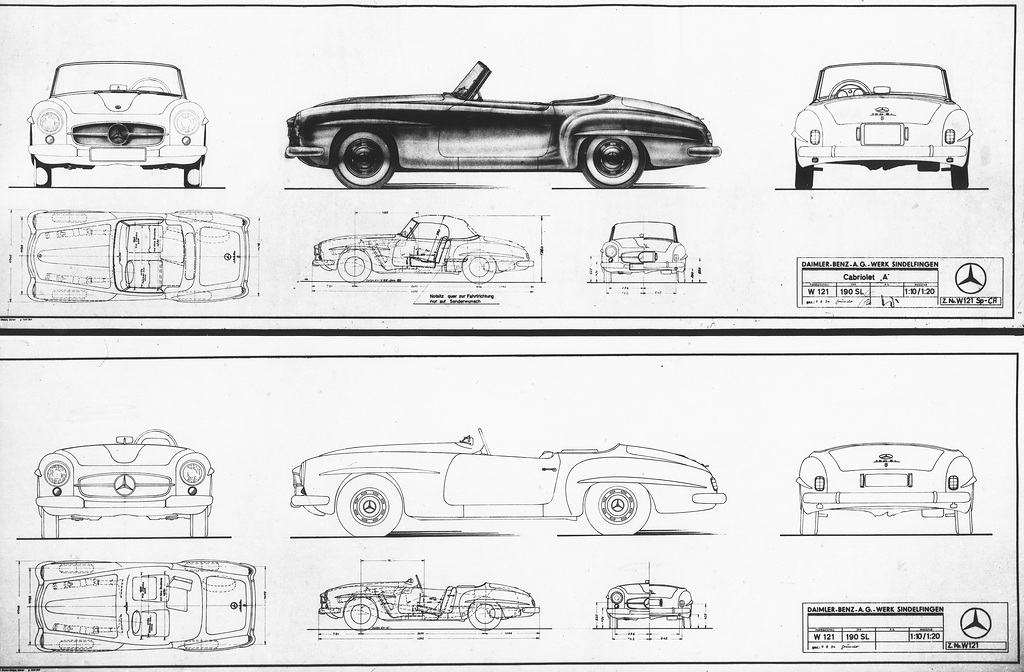
Mercedes-Benz 190 SL (W 121). Entwurfszeichnung vom 7. August 1954 von Walter Häcker, Chef-Karosseriekonstrukteur, zum Serienfahrzeug, das 1955 auf den Markt kam.
Mercedes-Benz 190 SL (W 121). Design drawing made on 7 August 1954 by Walter Häcker, chief body designer, for the production car that came out on the market in 1955
Innovation From the Start
Though it wasn’t to be as expensive as the 300SL, that didn’t mean that the new 190SL – the first purpose-built Mercedes-Benz roadster since before the War – would lack mechanical intrigue. The Mercedes 190 SL would introduce several firsts for Mercedes Benz. This included a monocoque sports car chassis and a clever low-pivot rear suspension. The former was developed from the 180-saloon frame – with its wheelbase cut down by 10 inches Introduced just a year before the prototype 190SL, the ‘Ponton’ was the first Mercedes-Benz with a unitary chassis. Yet much like its separate-chassis predecessor, it could still be readily modified for coupe, saloon or even convertible applications. A roadster therefore wasn’t deemed too much of a stretch – or should that be chop? Incidentally, the nickname of Ponton (German for pontoon) refers to this important new mass-market saloon’s full-width front wings.
On the motive power front, the Mercedes 190 SL lacked the fuel-injection of its far more expensive 300SL sibling. But that didn’t mean its running gear lacked any sporty enhancements. Its newly developed 1.9-litre, chain-driven, twin-Solex carburettor fed four-cylinder engine was nothing to write home about. However, in terms of power output at least – the 190SL’s rear suspension certainly was…
An Old Favourite
The old favourite Mercedes-Benz swing-axle setup – as fitted to the 300SL – was tricky to handle when pushed hard. As with all swing axles, the M-B version could ‘jack up’ if the driver lost confidence mid-corner. Engineers remedied this when they lifted the suspension from the W196 racing car, putting it into production for the new 220 saloon in 1954. They then transferred the same system to the Mercedes 190 SL. The new setup had two major new improvements. Firstly, it limited rear suspension travel, making it far less susceptible to adverse geometry in the first instance. Secondly it placed the rear suspension’s centre pivot below the differential. This latter trick elongated the half shafts and lowered the car’s roll centre greatly improving stability.
These tandem solutions proved so effective that engineers added it to the 300SL. The 190SL lacked the outright firepower of its more glamourous sibling. It lacked the outputs of most of America’s rival imported sports cars like the Porsche 356 and Jaguar XK120. But it could certainly match or better most of the competition on the all-important twisty canyon roads of Southern California.
A Touch of Class
It might seem trivial, nearly seventy years later, but innovations such as an overhead camshaft-driven engine, winding windows, an all-synchromesh four-speed manual transmission and independent heating controls for driver and passenger were big deals in the mid-1950s. Even having a monocoque chassis was unusual back then. Most American sporting machines kept a separate chassis well into the new millennium. Add in sophisticated rear suspension, a fully-lined hood, exceptional build quality and comprehensive instrumentation, plus lavish trim and timeless good looks, and the 190SL’s standard equipment was well ahead of the curve. All of which could be yours for just $3998 – no wonder it sold by the boat load.
Arriving on the market in May 1955, the Mercedes 190SL immediately set tongues wagging. Many, especially outside America, hadn’t experienced this revolutionary roadster’s myriad of talents. The perfect blending of style, effortless class and sporting mystique. US customers instantly recognised its laid-back, luxurious approach as many of its home-grown best sellers were doing the same. It’s no surprise that Americans couldn’t get enough, buying up 40 percent of all the 25,881 Mercedes-Benz 190 SLs made (for export). The success of this SL in the States did wonders for Stuttgart’s recovering coffers. It guaranteed the continuation of a dynasty we’re fortunate enough to still enjoy to this day.
Sporty Rather Than Racy
We’ve become used to the SL’s near unique mix of sporting and touring talent today, but the 190SL was the model that set this standard. The car’s character was deliberately designed to be less of an outright sports car. Its large wheel, comfortable cabin and leisurely performance added up to a grown-up machine. Perfect for those who valued graceful progress in style above outright performance. Though that’s not to say that Mercedes completely ignored its inheritance gained from the 300SL’s competition success.
Though it was never intended to do so, if you wanted to take your 190 SL racing, Mercedes-Benz was happy to oblige. An optional ‘Rennsport’ kit was available to convert the car into a semi-competitive club racer. This option saw the windscreen swapped for a cut-down, low-drag plexiglass aero alternative. The doors were also lightened with the hood and its frame, bumpers and trim removed to save weight. In a further attempt to shed some pounds, lighter bucket seats were also fitted. However, the car remained too heavy and lacked the power to be an outright winner. Although, that didn’t stop weekend racers from taking laurels in 190SLs. Douglas Steane won his class at the 1956 Maccau Grand Prix in one, though this SL never came close to matching its big brother’s racing triumphs.
The Mercedes 190SL Market
The figures for exported SLs from this era mean that European cars, especially those in right-hand drive, are now highly sought after. The same goes for hot-climate exports that place the driver on the right side of the cabin. Our very own resident SL expert and director Bruce Greetham has kept a keen eye on the values of these exceptional machines and shares the following pearls of wisdom. “The Mercedes 190SL was not particularly prominent in its heyday, making a fully-restored condition, right-hand drive 190SL – especially one built pre-1957 – command up to £160-£170k. The appeal of these cars revolves around their eligibility for historic endurance races, such as the Mille Miglia.
A Good Car
“A ‘good car’ that is both original and in usable condition, would sit around the £125k mark, depending on that condition. Below this, you would be expecting to pay under £100k. Fully-restored left-hand drive vehicles tend to sit 10-15% lower in value than the above, while those built in the last few years (1961-63) can be picked up for £70k.” There’s no denying the general march of SL appreciation that’s occurring at the moment across all eras but there are specific reasons to be even more optimistic with the 190SL, as Bruce explains. “There’s no reason why the particularly desirable specification examples mentioned couldn’t rise up to the £200k mark over the next 3-year period. This is down to the continued and exponential increase in Pagoda SL values.”
Buying one of these classic 190 SLs would be the realisation of a dream for most classic car enthusiasts, but with predictions like those above, perhaps you’d better get in soon. The pool of good cars is only getting smaller, though rest assured, we here at the SLSHOP have the expertise and experience to not only find you a good one but keep it that way long-term. Whether it’s an example that needs a ground-up restoration or merely one that deserves to be kept in fine fettle, we can advise you correctly – based on experience – to keep costs to a minimum. We can also find those spare parts that might leave other scratching their heads. To find out more why not give us a call on +44 (0) 1789 337070 or click to view all our available 190 SL W121 parts.
Share With Your Fellow Enthusiasts
It’s the Mercedes 190 SL that kicked off the lineage as we know it. It emerged from the halcyon days of the post war miracle. This German American ‘boomer’ healed old wounds and made dreams come true.
The International Motor Sports Show, took place during a typically cold New York February back in 1954. At the time those attending didn’t know that they were to witness the birth of something very special. Barely a decade after the end of the Second World War, a modest Mercedes-Benz display was dwarfed by that of next-door neighbours (and fierce rivals) Jaguar. Yet two of the Stuttgart concern’s four cars exhibited that week would prove pivotal to the firm’s 1950s revival. Pride of place was naturally reserved for the headline-grabbing 300SL ‘Gullwing’. But in its shadow was the handsome Mercedes 190 SL prototype convertible. It would go on to successfully extend the SL name from the racetrack to the road. The beloved Mercedes 190 SL as we now know it.
The American Dream
By the mid-1950s Americana had become the cultural and aspirational blueprint for much of the developed world. Emerging largely unscathed and economically booming post-War, America was riding high. Car ownership exploded and towards the end of the decade, baby boomers were now old enough to drive. These hip youngsters wouldn’t be seen dead in the bland saloons their parents drove. They wanted new and exciting cars that reflected their rock & roll lifestyle. New exciting cars like the Ford Thunderbird and Chevrolet Corvette that exuded sex appeal. Mercedes-Benz didn’t build anything like this (for the same price) at the time. They probably wouldn’t have done so, were it not for the machinations of a certain Maximillian Edwin Hoffman.
Austrian-born Hoffman had made his name as a prolific importer of European luxury and sports cars. He sold thousands annually from his famous Llyod-Wright designed Manhattan showrooms. Hoffman’s credits included persuading BMW to make its 507 and Porsche its 356 Speedster. As a result, when he told manufactures what his American customers wanted, they listened.
A New Era
Hoffman mentioned to Mercedes-Benz that if it made a convertible sports car, he could sell it. The competition success of the 300SL gave the brand the ideal jump-off for a salesman after all. He’d already managed to twist Stuttgart’s arm into making the 300SL road car a reality – even at an eye-wateringly expensive cost to the customer of $7000. What they needed was a new, affordable roadster that could compete on US soil with the aforementioned Fords and Chevys and cost less than $4000. The Mercedes 190 SL would become the catalyst for a new era of wealthy owners – young and old.

Mercedes-Benz 190 SL (W 121). Entwurfszeichnung vom 7. August 1954 von Walter Häcker, Chef-Karosseriekonstrukteur, zum Serienfahrzeug, das 1955 auf den Markt kam.
Mercedes-Benz 190 SL (W 121). Design drawing made on 7 August 1954 by Walter Häcker, chief body designer, for the production car that came out on the market in 1955
Innovation From the Start
Though it wasn’t to be as expensive as the 300SL, that didn’t mean that the new 190SL – the first purpose-built Mercedes-Benz roadster since before the War – would lack mechanical intrigue. The Mercedes 190 SL would introduce several firsts for Mercedes Benz. This included a monocoque sports car chassis and a clever low-pivot rear suspension. The former was developed from the 180-saloon frame – with its wheelbase cut down by 10 inches Introduced just a year before the prototype 190SL, the ‘Ponton’ was the first Mercedes-Benz with a unitary chassis. Yet much like its separate-chassis predecessor, it could still be readily modified for coupe, saloon or even convertible applications. A roadster therefore wasn’t deemed too much of a stretch – or should that be chop? Incidentally, the nickname of Ponton (German for pontoon) refers to this important new mass-market saloon’s full-width front wings.
On the motive power front, the Mercedes 190 SL lacked the fuel-injection of its far more expensive 300SL sibling. But that didn’t mean its running gear lacked any sporty enhancements. Its newly developed 1.9-litre, chain-driven, twin-Solex carburettor fed four-cylinder engine was nothing to write home about. However, in terms of power output at least – the 190SL’s rear suspension certainly was…
An Old Favourite
The old favourite Mercedes-Benz swing-axle setup – as fitted to the 300SL – was tricky to handle when pushed hard. As with all swing axles, the M-B version could ‘jack up’ if the driver lost confidence mid-corner. Engineers remedied this when they lifted the suspension from the W196 racing car, putting it into production for the new 220 saloon in 1954. They then transferred the same system to the Mercedes 190 SL. The new setup had two major new improvements. Firstly, it limited rear suspension travel, making it far less susceptible to adverse geometry in the first instance. Secondly it placed the rear suspension’s centre pivot below the differential. This latter trick elongated the half shafts and lowered the car’s roll centre greatly improving stability.
These tandem solutions proved so effective that engineers added it to the 300SL. The 190SL lacked the outright firepower of its more glamourous sibling. It lacked the outputs of most of America’s rival imported sports cars like the Porsche 356 and Jaguar XK120. But it could certainly match or better most of the competition on the all-important twisty canyon roads of Southern California.
A Touch of Class
It might seem trivial, nearly seventy years later, but innovations such as an overhead camshaft-driven engine, winding windows, an all-synchromesh four-speed manual transmission and independent heating controls for driver and passenger were big deals in the mid-1950s. Even having a monocoque chassis was unusual back then. Most American sporting machines kept a separate chassis well into the new millennium. Add in sophisticated rear suspension, a fully-lined hood, exceptional build quality and comprehensive instrumentation, plus lavish trim and timeless good looks, and the 190SL’s standard equipment was well ahead of the curve. All of which could be yours for just $3998 – no wonder it sold by the boat load.
Arriving on the market in May 1955, the Mercedes 190SL immediately set tongues wagging. Many, especially outside America, hadn’t experienced this revolutionary roadster’s myriad of talents. The perfect blending of style, effortless class and sporting mystique. US customers instantly recognised its laid-back, luxurious approach as many of its home-grown best sellers were doing the same. It’s no surprise that Americans couldn’t get enough, buying up 40 percent of all the 25,881 Mercedes-Benz 190 SLs made (for export). The success of this SL in the States did wonders for Stuttgart’s recovering coffers. It guaranteed the continuation of a dynasty we’re fortunate enough to still enjoy to this day.
Sporty Rather Than Racy
We’ve become used to the SL’s near unique mix of sporting and touring talent today, but the 190SL was the model that set this standard. The car’s character was deliberately designed to be less of an outright sports car. Its large wheel, comfortable cabin and leisurely performance added up to a grown-up machine. Perfect for those who valued graceful progress in style above outright performance. Though that’s not to say that Mercedes completely ignored its inheritance gained from the 300SL’s competition success.
Though it was never intended to do so, if you wanted to take your 190 SL racing, Mercedes-Benz was happy to oblige. An optional ‘Rennsport’ kit was available to convert the car into a semi-competitive club racer. This option saw the windscreen swapped for a cut-down, low-drag plexiglass aero alternative. The doors were also lightened with the hood and its frame, bumpers and trim removed to save weight. In a further attempt to shed some pounds, lighter bucket seats were also fitted. However, the car remained too heavy and lacked the power to be an outright winner. Although, that didn’t stop weekend racers from taking laurels in 190SLs. Douglas Steane won his class at the 1956 Maccau Grand Prix in one, though this SL never came close to matching its big brother’s racing triumphs.
The Mercedes 190SL Market
The figures for exported SLs from this era mean that European cars, especially those in right-hand drive, are now highly sought after. The same goes for hot-climate exports that place the driver on the right side of the cabin. Our very own resident SL expert and director Bruce Greetham has kept a keen eye on the values of these exceptional machines and shares the following pearls of wisdom. “The Mercedes 190SL was not particularly prominent in its heyday, making a fully-restored condition, right-hand drive 190SL – especially one built pre-1957 – command up to £160-£170k. The appeal of these cars revolves around their eligibility for historic endurance races, such as the Mille Miglia.
A Good Car
“A ‘good car’ that is both original and in usable condition, would sit around the £125k mark, depending on that condition. Below this, you would be expecting to pay under £100k. Fully-restored left-hand drive vehicles tend to sit 10-15% lower in value than the above, while those built in the last few years (1961-63) can be picked up for £70k.” There’s no denying the general march of SL appreciation that’s occurring at the moment across all eras but there are specific reasons to be even more optimistic with the 190SL, as Bruce explains. “There’s no reason why the particularly desirable specification examples mentioned couldn’t rise up to the £200k mark over the next 3-year period. This is down to the continued and exponential increase in Pagoda SL values.”
Buying one of these classic 190 SLs would be the realisation of a dream for most classic car enthusiasts, but with predictions like those above, perhaps you’d better get in soon. The pool of good cars is only getting smaller, though rest assured, we here at the SLSHOP have the expertise and experience to not only find you a good one but keep it that way long-term. Whether it’s an example that needs a ground-up restoration or merely one that deserves to be kept in fine fettle, we can advise you correctly – based on experience – to keep costs to a minimum. We can also find those spare parts that might leave other scratching their heads. To find out more why not give us a call on +44 (0) 1789 337070 or click to view all our available 190 SL W121 parts.
Share With Your Fellow Enthusiasts
More from Journal
CARE
THE ULTIMATE CERTIFIED SERVICING INVESTMENT PLAN
Your ownership journey matters to us, which is why we have created a simple certified servicing investment plan, tailored to your individual needs and aspirations.
Start investing today and our dedicated CARE team will work with you to increase the value and enjoyment you receive from your vehicle.

STAY IN TUNE WITH SLSHOP MOMENTS
As part of SLSHOP’s community of enthusiasts, you’ll be the first to hear about events and tours, key product offers, exciting stories from owners around the world and of course… our latest additions to the showroom. So, be the first to know and you might just sneak a car on your driveway or take your car’s condition to new heights with our exclusive replacement parts.
Or, visit SLSHOP Journal
